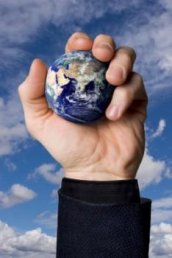List of Environmental Threats
The seven biggest environmental threats to the Earth are issues every person should understand and take action to see that these threats are eventually eliminated.
Examining the various threats to the Earth's environment must include the human impact on the planet. Catch phrases such as carbon footprint, global warming, deforestation, and other commonly used terms have become the everyday jargon for those concerned about the environment.
1. Human Population and Pollution
A growing world population might seem like an obvious threat to the environment that goes far beyond the debatable theory of global warming. The bigger threat is far more complex and directly linked not to the controversial idea of a carbon footprint, but to the unique system of supply and demand.
Consumers place more and more demands on the earth's natural resources as the population increases year after year. These demands leave pollution and waste in the wake of human daily activity. Compound this with each world government doing its own brand of commerce, many without environmental consciences, and you get the formula for environmental chaos and disaster.
A prime example of higher consumption demands can be found in the fishery industry, where the world's marine life is being harvested with few to no renewable methods in place. Consumers are also responsible via industry for hundreds of hazardous chemicals used in the production of various products. Heavy metals continue to contaminate land, water and air.
The power of a consumer can be mighty when each person in the world realizes that action can be taken and changes made by carefully choosing how each consumer dollar is spent.
2. Earth Changes
The last major climate change was an ice age and the world is in the final stages of that event. The result is a rise in temperatures and the melting of glaciers and even the polar ice cap. Many highly-respected scientists disagree that global warming is the result of human-caused pollution any more than it can cause powerful hurricanes, tsunamis, earthquakes, floods, and even solar flares. This school of thought views earth changes as being the result of the natural processes found in an evolving living planet and its sun. While the cause of global warming remains controversial, both sides agree that it's a very real environmental threat to the world as you know it.
3. Deforestation
When a region loses its biodiversity, it becomes more vulnerable to other environmental elements. Deforestation disrupts the natural balance of ecological systems in the area where the trees have been harvested and far beyond. Food production can be impacted due to drought and erosion directly linked to the loss of forests.
4. Ozone Deterioration
Chemicals and chlorofluorocarbons pollutants are created by industry and agriculture. They have a negative impact the ozone layer. The lack of strict enforcement of laws to prevent the use of such pollutants compounds the situation. World governments that continue to allow various pollutants into the environment impede the recovery of the ozone layer.
5. Acid Rain
Acid rain is created by excessive sulfuric and nitric acid being pumped into the atmosphere, rivers, oceans, and land. While some acid rain is the byproduct of the natural processes of decaying vegetation and volcanic activity, the current crisis comes directly from the burning of fossil fuels. Water becomes toxic when acid rain imbues the oceans or lakes with an absorption quality that cause the water to absorb soil-based aluminum and poisons the aquatic plant and marine life.
6. Dead Zones in the Ocean
Another harmful source of excessive nitrogen being dumped into the oceans can be traced back to agricultural practices of over-fertilization of crops, lawns and gardens. The end result has been the creation of over 160 dead zones throughout the world's oceans.
The oceans' eco-systems are dependent upon the natural process of organic ocean matter known as phytoplankton, which is found on ocean surfaces. This eventually breaks down and filters to the bottom of the ocean floor where it's broken down further by ocean floor bacteria. This process is called bacterial respiration.
When too much nitrogen feeds the phytoplankton, like any fertilized crop, it begins to overproduce. The bacteria are unable to break down the plankton fast enough and the chemical processes that convert carbon dioxide into oxygen can't keep up. The oxygen is used up quicker than it can be produced. The plankton chokes out the flow of water and oxygen so that marine and plant life die from the lack of oxygen.
7. Species Extinction
An alarming rate of species extinction is happening worldwide. As of 2010, the rate of loss is estimated to be more than 1, 000 times the normal rate. Greater preservation tactics and strategies are needed with laws put into place to protect species. Once more, manmade pollution is the culprit along with land encroachment by developers. Both causes are created by consumer demands as people branch out into areas that were once remote habitats for various species.
An example of successful endangered species preservation is the American national symbol, the bald eagle. In the 1960s, there were fewer than 470 eagle nestlings. As of 2010, there were over 7, 000 nestlings in the United States. This increase in the bald eagle population demonstrates how threatened species can be brought back from the brink of extinction. More and more animals and other forms of wildlife are being added to the endangered species list each year. It makes sense to become better land stewards, instead of encroaching on forests and wetlands.
http://center-fest.ru/postreleases/mujskie-oblegayuschie-i-pritalennyie-svitera/










